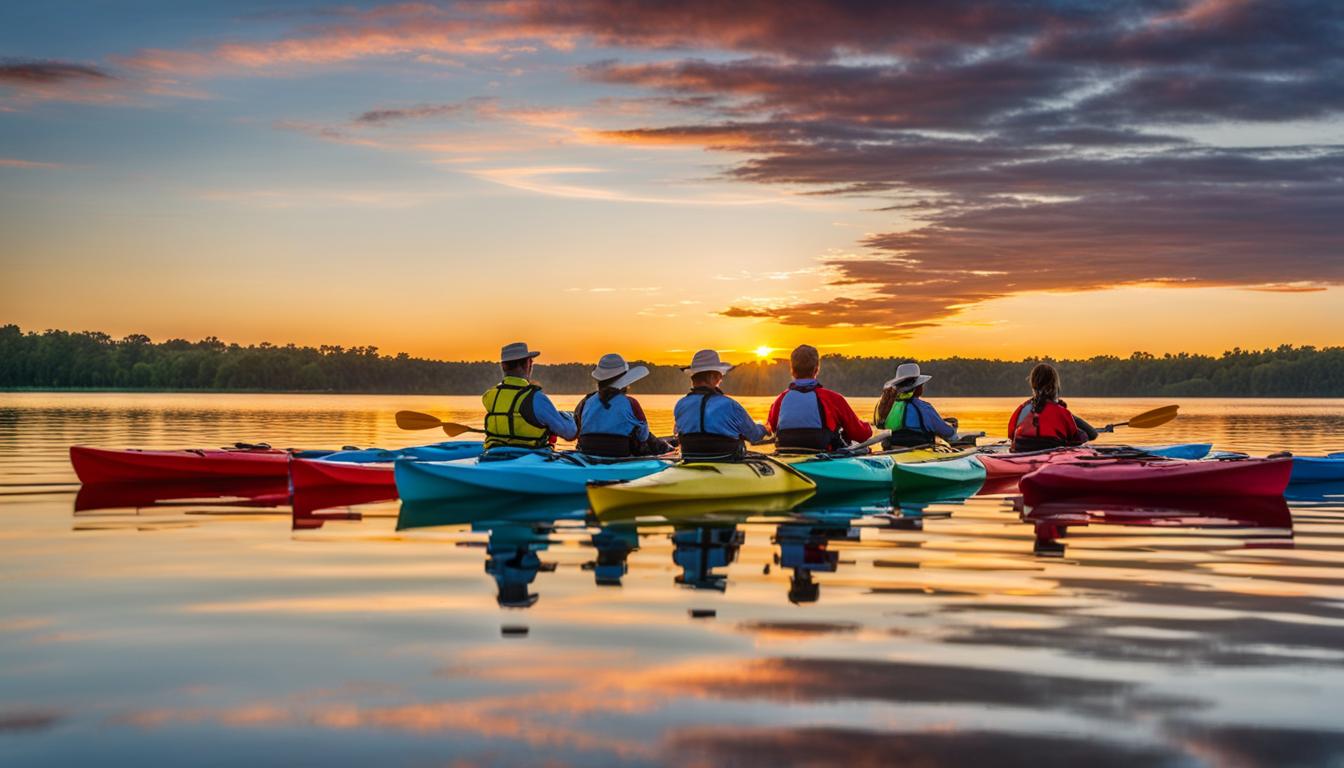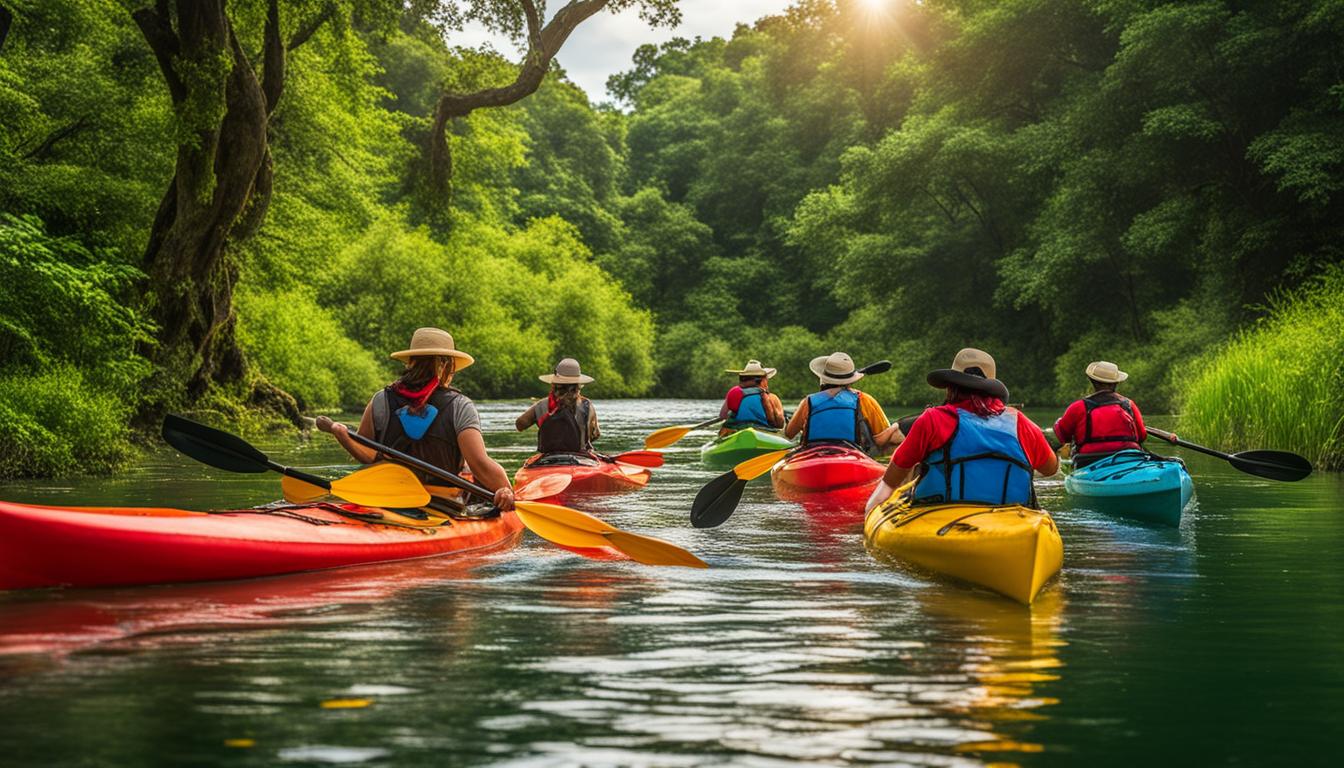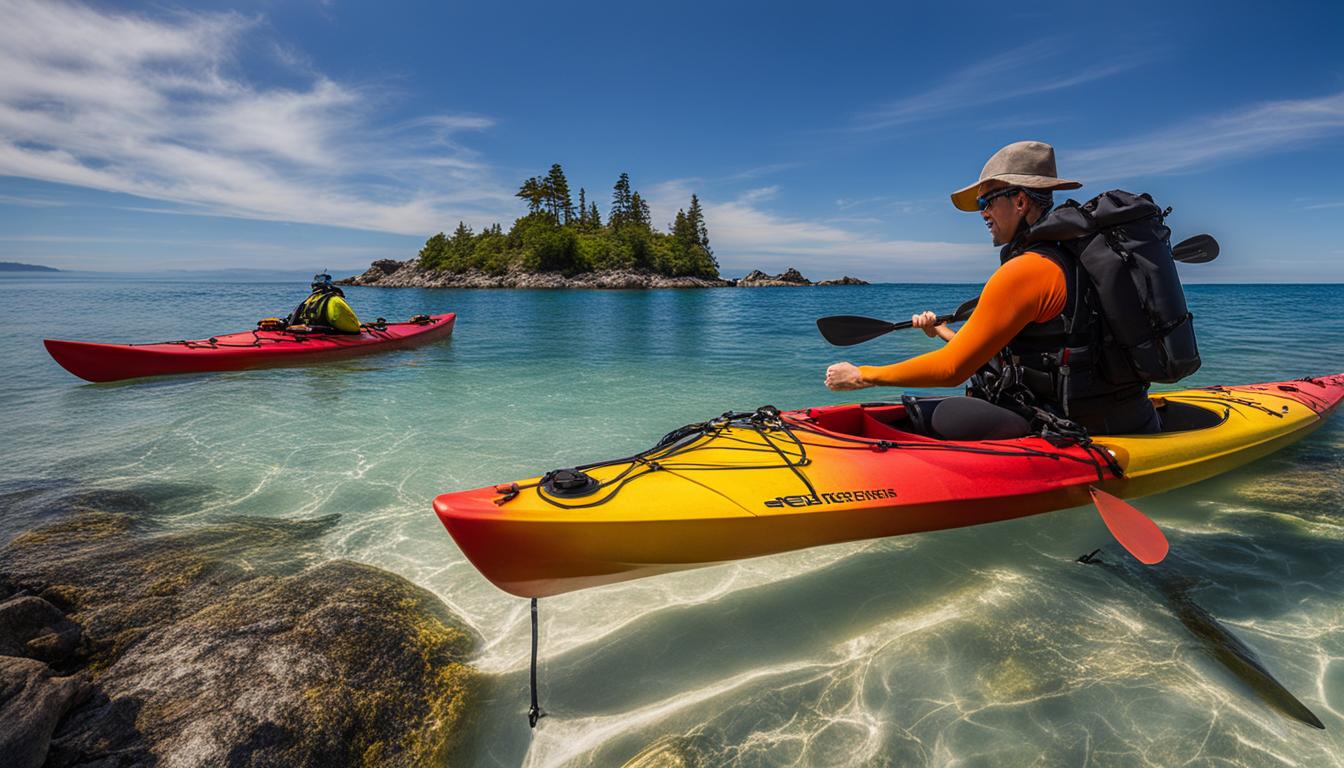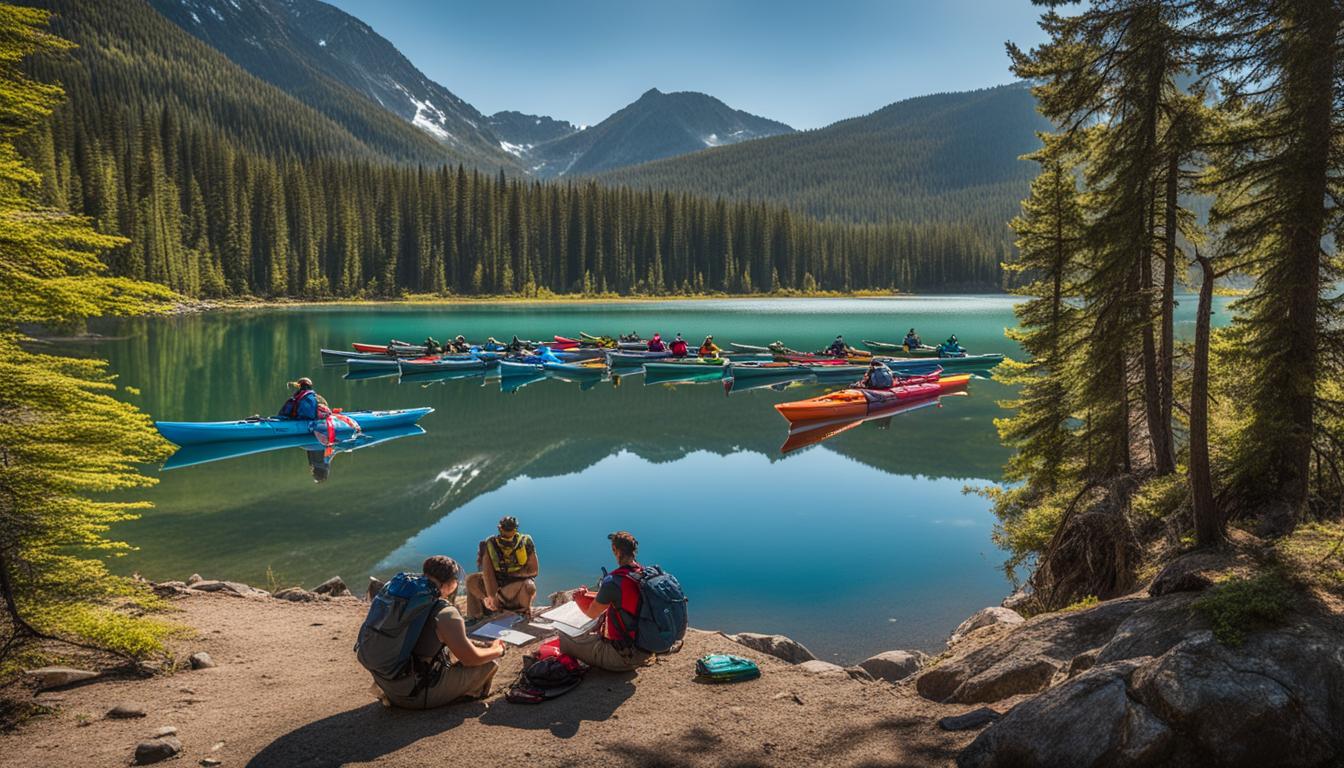Kayak camping in national parks offers a unique and immersive way to experience the beauty of nature. Whether you’re a beginner or an experienced paddler, national parks across the United States offer stunning waterways to explore by kayak.
In this comprehensive guide, we will provide tips and information on planning your national park kayak camping trip, the best national parks for kayaking, and the regulations you need to know. Get ready to embark on an aquatic adventure like never before.
Key Takeaways:
- Discover the beauty of national parks by kayaking and camping.
- Explore stunning waterways and immerse yourself in nature.
- Plan your trip and familiarize yourself with the regulations for kayak camping in national parks.
- Consider the best time to visit and where to stay for your kayak camping adventure.
- Embrace the National Water Trails system for guided kayak trips and self-guided adventures.
Channel Islands National Park: An Oceanic Paradise for Kayak Campers
Discover the hidden treasures of Channel Islands National Park, a pristine oasis for kayak camping enthusiasts. Located off the coast of Southern California, this national park is a protected marine ecosystem consisting of five stunning islands. Immerse yourself in the beauty of these waters as you paddle through sea caves, encounter diverse marine life, and witness breathtaking scenic views.
With over 2,000 species of plants and animals, including the iconic island fox, Channel Islands National Park offers a unique opportunity to explore a rich and thriving ecosystem. As you kayak along the coastline, be prepared to be amazed by the vibrant kelp forests, diverse bird populations, and the possibility of encountering seals, dolphins, and even whales. The crystal-clear waters provide a window into an underwater world teeming with life.
“Channel Islands National Park is a hidden gem for kayak camping enthusiasts. The combination of pristine waters, stunning landscapes, and abundant wildlife make it a truly unforgettable experience.”
Whether you’re a beginner or an experienced paddler, this oceanic paradise offers something for everyone. Choose from guided tours or embark on a self-guided adventure, exploring the unique features of each island. From Santa Cruz Island’s sea caves to Anacapa Island’s iconic arches, there are countless opportunities for exploration and discovery.
| Island | Main Attraction |
|---|---|
| Santa Cruz Island | Scenic sea caves and rugged coastline |
| Anacapa Island | Iconic arches and diverse bird populations |
| Santa Rosa Island | Beautiful beaches and historic ranching sites |
| Santa Barbara Island | Abundant marine life and vibrant kelp forests |
| San Miguel Island | Remote landscapes and unique plant species |
When planning your kayak camping trip to Channel Islands National Park, remember to check the park’s regulations and obtain the necessary permits. Due to the park’s protected status, camping is limited to designated areas, ensuring the preservation of its fragile ecosystems. Additionally, be mindful of the tides and weather conditions, as they can greatly impact your kayaking experience.
Channel Islands National Park is a hidden gem where you can immerse yourself in the beauty of nature and experience the wonders of a protected marine ecosystem. Whether you’re seeking exhilarating sea cave explorations, peaceful moments surrounded by breathtaking landscapes, or thrilling encounters with wildlife, this oceanic paradise offers it all.
North Cascades National Park: Glaciers and Serene Waters Await
For kayakers seeking a more remote and challenging experience, North Cascades National Park in Washington State is a must-visit destination. With its stunning glaciers and serene waters, this park offers unparalleled beauty. Paddle along the 35 riverways and canals that make up the National Water Trails system, and immerse yourself in the rugged landscapes and abundant wildlife. From the North Cascades highway to Diablo and Ross lakes, there are endless opportunities for exploration and adventure.
North Cascades National Park is known for its breathtaking glaciers, which offer a magnificent backdrop for kayaking. The park is home to more than 300 glaciers, including the massive Boston Glacier and the awe-inspiring Cascade Glacier. As you paddle along the park’s waterways, you’ll have the chance to see these incredible natural wonders up close and personal.
In addition to glaciers, North Cascades National Park boasts a network of serene lakes and rivers that are perfect for kayaking. Diablo and Ross lakes, which are both accessible by road, offer calm waters and stunning mountain views. These lakes are ideal for kayakers of all skill levels, from beginners to experienced paddlers.
Kayaking in North Cascades National Park
When planning your kayaking trip to North Cascades National Park, it’s important to be prepared for the challenging conditions that may arise. The park’s remote location and rugged terrain mean that kayakers should have experience and be prepared for varying weather conditions, including sudden storms and strong winds.
It’s also crucial to have the necessary equipment and safety gear, such as a personal flotation device (PFD), a helmet, and a paddle leash. Additionally, it’s recommended to check local regulations and obtain any necessary permits before embarking on your kayaking adventure.
Overall, North Cascades National Park offers a unique and unforgettable kayaking experience for those seeking a true outdoor adventure. With its breathtaking glaciers, serene waters, and endless opportunities for exploration, this park is truly a hidden gem for kayakers.
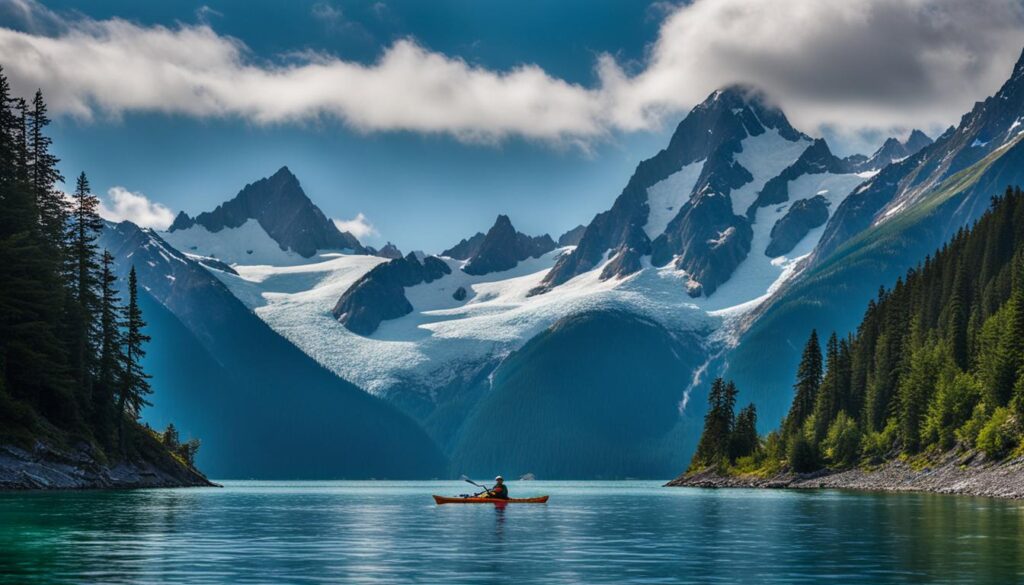
| Park Highlights | Best Time to Visit | Recommended Trails |
|---|---|---|
| Stunning glaciers | Summer months | Diablo and Ross lakes |
| Serene lakes and rivers | Fall for vibrant foliage | North Cascades Highway |
| Rugged landscapes | Spring for wildflowers | Stehekin River |
| Abundant wildlife | Year-round for hiking | Square Lake |
Canyonlands and Capitol Reef National Parks: The Hidden Gems of the Southwest
If you’re looking for a unique kayaking adventure away from the crowds, look no further than Canyonlands and Capitol Reef National Parks. These hidden gems in the Southwest offer stunning landscapes and incredible opportunities for kayak exploration.
Exploring Canyonlands National Park
Canyonlands National Park, located in southeastern Utah, is a true haven for outdoor enthusiasts. With its vast canyons, towering mesas, and stunning red rock formations, this park is a paradise for kayakers. The Green and Colorado Rivers cut through the park, creating a labyrinth of canyons and waterways to explore. As you paddle through the calm waters, you’ll be surrounded by breathtaking views and the tranquility of nature.
“Kayaking in Canyonlands National Park is like entering another world. The towering cliffs, narrow canyons, and the sense of solitude make it an unforgettable experience.” – Experienced Kayaker
Discovering Capitol Reef National Park
Capitol Reef National Park, located in south-central Utah, is known for its unique geology and colorful rock formations. The park’s Waterpocket Fold, a 100-mile-long warp in the Earth’s crust, offers a stunning backdrop for kayakers. The Fremont River flows through the park, providing a serene and picturesque setting for paddling. As you navigate through the waterways, you’ll have the opportunity to observe the park’s diverse wildlife and experience the beauty of the Southwest up close.
“Kayaking in Capitol Reef National Park is like stepping back in time. The ancient rock formations and the solitude of the river create a sense of peace and wonder.” – Nature Enthusiast
Comparing Canyonlands and Capitol Reef
| Canyonlands National Park | Capitol Reef National Park | |
|---|---|---|
| Location | Southeastern Utah | South-central Utah |
| Key Features | Vast canyons, towering mesas, Green and Colorado Rivers | Waterpocket Fold, Fremont River |
| Wildlife | Abundant bird species, desert bighorn sheep, coyotes | Mule deer, bobcats, mountain lions |
| Best Time to Visit | Spring and fall for milder temperatures | Spring and fall for milder temperatures |
| Kayaking Difficulty | Moderate to difficult | Moderate |
When comparing Canyonlands and Capitol Reef National Parks, both offer unique and memorable kayak experiences. Canyonlands is known for its towering cliffs and narrow canyons, making it a more challenging kayaking destination. Capitol Reef, on the other hand, provides a slightly easier paddling experience with its picturesque river and colorful rock formations. Both parks offer incredible opportunities for wildlife sightings and stunning scenery. Whether you’re an experienced kayaker or a beginner, these hidden gems in the Southwest are not to be missed.
Theodore Roosevelt National Park: Embrace Your Inner Cowboy on the Water
Embrace your inner cowboy and embark on a one-of-a-kind adventure in Theodore Roosevelt National Park. Nestled in the rugged plains of North Dakota, this hidden gem offers a unique opportunity for kayak camping enthusiasts to explore its pristine rivers and canyons. With its vast landscapes and rich history, Theodore Roosevelt National Park is a paradise for those seeking a true Western experience like no other.
To make the most of your kayak camping trip, here are some essential tips to keep in mind:
- Plan your trip in advance: Research the park’s regulations, permits, and camping options to ensure a smooth and enjoyable experience.
- Choose the right kayak: Opt for a stable and maneuverable kayak that suits your skill level and the type of water you’ll be navigating.
- Pack smart: Bring essential camping gear, including a tent, sleeping bag, cooking supplies, and food. Don’t forget to pack plenty of water and sunscreen to stay hydrated and protected from the sun’s rays.
- Respect wildlife and nature: Keep a safe distance from wildlife, follow designated trails, and leave no trace of your presence to help preserve the park’s natural beauty.
With these tips in mind, you’re ready to embark on an unforgettable kayak camping journey through the picturesque rivers and canyons of Theodore Roosevelt National Park. Experience the tranquility of drifting along the water, surrounded by the untouched beauty of the Wild West. Unleash your inner cowboy and let Theodore Roosevelt National Park ignite your sense of adventure.
Testimonials
“Kayak camping in Theodore Roosevelt National Park was a transformative experience. The vastness of the landscapes and the serenity of the water made me feel connected to nature in a profound way. It’s the perfect destination for those seeking a unique outdoor adventure.”
Jane Thompson, Outdoor Enthusiast
“Theodore Roosevelt National Park exceeded all my expectations. Kayaking along the park’s rivers allowed me to explore its hidden corners and marvel at the diverse wildlife. It truly felt like stepping back in time and immersing myself in the spirit of the Old West.”
Mike Anderson, Nature Lover
Explore the National Water Trails: Unlocking the Beauty of U.S. Waterways
When it comes to kayaking adventures in national parks, the National Water Trails system is a hidden gem worth exploring. With designated trails spanning across 25 U.S. states, these trails offer guaranteed public access to some of the most breathtaking waterways in the country. Whether you’re a novice or an experienced paddler, the National Water Trails provide unique opportunities for guided kayak trips and self-guided adventures.
The National Water Trails system not only ensures access to stunning waterways but also offers educational activities and resources for paddlers. Whether you’re interested in wildlife conservation, learning about local history, or simply immersing yourself in the beauty of nature, these trails provide a wealth of knowledge and experiences along the way.
From the picturesque Erie Canalway Heritage Corridor in New York State to the awe-inspiring Black Canyon Water Trail in Arizona and Nevada, there are water trails for every preference and skill level. Whether you’re seeking a leisurely paddle through peaceful marshlands or an adrenaline-pumping whitewater adventure, the National Water Trails have something for everyone.
Explore the National Water Trails
| Trail | Location | Length | Highlights |
|---|---|---|---|
| Erie Canalway Heritage Corridor | New York State | 365 miles | Historical sites, charming towns, wildlife |
| Black Canyon Water Trail | Arizona and Nevada | 30 miles | Scenic canyons, hot springs, wildlife |
| Great Calusa Blueway Paddling Trail | Florida | 190 miles | Mangrove tunnels, manatees, bird watching |
| Chesapeake Bay Gateways Network | Maryland, Virginia | 3,000 miles | Historical sites, lighthouses, wildlife |
So, grab your paddle and get ready to embark on an unforgettable journey along the National Water Trails. Whether you choose to join a guided kayak trip or venture out on your own, these trails offer a unique way to connect with nature and explore the beauty of U.S. waterways. Discover hidden gems, encounter wildlife, and create lasting memories as you unlock the wonders of the National Water Trails.
Best Time to Visit and Where to Stay: Planning Your National Park Kayak Camping Trip
When planning your national park kayak camping trip, it’s important to consider the best time to visit and where to stay. Each park has its own regulations regarding kayak camping, so be sure to familiarize yourself with the rules and guidelines. Additionally, consider the weather conditions and seasonal closures of certain areas. Camping options vary from walk-in campgrounds to remote beach camping, offering a range of experiences for different preferences. Research and plan accordingly to make the most of your national park kayak camping adventure.
Regulations and Guidelines
Before embarking on your national park kayak camping trip, it’s crucial to understand and adhere to the park’s regulations. These regulations are in place to protect both the natural environment and the safety of visitors. Some common regulations include restrictions on campfire use, camping permits, and proper disposal of waste. Additionally, many parks have specific guidelines for kayak camping, such as designated launch and landing areas and restrictions on the use of motorized watercraft. Familiarize yourself with these regulations before your trip to ensure a smooth and enjoyable experience.
Weather Considerations
The weather can greatly impact your national park kayak camping trip, so it’s important to plan accordingly. Check the forecast for the park and surrounding areas to ensure you pack appropriate clothing and gear. Keep in mind that weather conditions can change quickly, especially in mountainous regions, so be prepared for unexpected changes. It’s also important to be aware of seasonal closures, as some areas may be inaccessible during certain times of the year due to snow or other weather-related factors. Research the best time to visit the park for kayaking and plan your trip accordingly.
Accommodation Options
When it comes to where to stay during your national park kayak camping trip, there are various options to consider. Many national parks offer walk-in campgrounds, which provide a rustic camping experience and are typically located near kayak launch areas. These campgrounds often have basic amenities such as restrooms and picnic tables. If you prefer a more remote and secluded experience, some national parks also offer backcountry camping or beach camping options. These campsites may require a longer hike or paddle to reach, but they offer a unique and immersive experience in nature. Research the available accommodation options at your chosen national park and choose the one that best fits your preferences and level of comfort.
| National Park | Kayak Camping Regulations | Best Time to Visit | Accommodation Options |
|---|---|---|---|
| Channel Islands National Park | Kayak launch and landing areas, no motorized watercraft | Year-round, but summer and fall offer warmer waters | Walk-in campgrounds and beach camping |
| North Cascades National Park | Designated launch and landing areas, camping permits required | Summer and early fall for milder weather | Walk-in campgrounds and backcountry camping |
| Canyonlands National Park | Restrictions on campfire use, camping permits required | Spring and fall for moderate temperatures | Walk-in campgrounds and backcountry camping |
| Capitol Reef National Park | Kayak launch and landing areas, no campfires | Spring and fall for pleasant weather | Walk-in campgrounds and backcountry camping |
| Theodore Roosevelt National Park | Designated launch and landing areas, camping permits required | Spring and fall for milder temperatures | Walk-in campgrounds and backcountry camping |
By carefully considering the best time to visit, understanding the regulations and guidelines, and choosing the right accommodation options, you can plan a national park kayak camping trip that meets your expectations and ensures a memorable experience. Remember to always prioritize safety and respect the natural environment during your adventure.

Conclusion
Kayak camping in national parks offers an exceptional opportunity to immerse yourself in nature and experience unforgettable adventures. From the picturesque coastlines of Channel Islands National Park to the majestic glaciers of North Cascades, there are endless wonders to explore.
By taking advantage of the National Water Trails system, you can embark on guided kayak trips or venture out on self-guided adventures through some of the most beautiful waterways in the United States. As you plan your national park kayak camping trip, be sure to familiarize yourself with the regulations and guidelines specific to each park. This will ensure a safe and enjoyable experience for you and the environment.
With diverse camping options available, ranging from walk-in campgrounds to remote beach camping, you can tailor your trip to suit your preferences. Research the best time to visit and consider the weather conditions to optimize your outdoor experience. Whether you’re an experienced paddler or new to kayaking, national park kayak camping provides a unique way to connect with nature and create lasting memories. So pack your gear, plan your trip, and get ready to embark on an extraordinary journey.
FAQ
What is kayak camping?
Kayak camping is a form of outdoor adventure where you travel and camp in a kayak. It allows you to explore different waterways and set up camp at designated spots along the journey.
Is kayak camping suitable for beginners?
Yes, kayak camping can be enjoyed by both beginners and experienced paddlers. However, it’s important to have some basic kayaking skills and knowledge of safety precautions before embarking on a kayak camping trip.
Are there any restrictions or regulations for kayak camping in national parks?
Yes, each national park has its own regulations regarding kayak camping. It’s important to familiarize yourself with these rules, including permits, camping locations, and any restrictions on waterways or camping equipment.
What are the best national parks for kayaking?
Some of the best national parks for kayaking include Channel Islands National Park in California, North Cascades National Park in Washington State, and Canyonlands and Capitol Reef National Parks in the American Southwest.
When is the best time to visit national parks for kayak camping?
The best time to visit national parks for kayak camping depends on the specific park and region. It’s important to consider factors such as weather conditions, seasonal closures, and peak tourist seasons when planning your trip.
Can I rent kayaks and camping gear at national parks?
Some national parks offer kayak and camping gear rentals, while others may require you to bring your own equipment. It’s best to check with the specific park or nearby outfitters for rental options.
What are the accommodation options for kayak camping in national parks?
Accommodation options for kayak camping in national parks vary from walk-in campgrounds to remote beach camping. Some parks may also offer backcountry camping permits for more adventurous campers.
Are there guided kayak trips available in national parks?
Yes, some national parks offer guided kayak trips along designated water trails. These trips provide opportunities for educational experiences and expert guidance, allowing you to fully immerse yourself in the beauty of the park.


